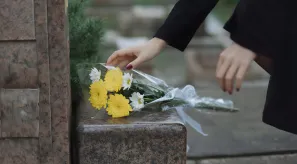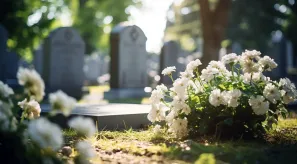In Buddhism, death is seen as part of a life cycle. It is something natural and inevitable that is not to be feared because, for Buddhists, death is the beginning of another life, and it will be repeated in successive reincarnations until Nirvana is reached. These beliefs influence the way Buddhist funerals are understood and organised. Today with Stelae, we will take a closer look at the characteristics of Buddhist funerals.
Basic concepts of a Buddhist funeral
In order to understand Buddhist funerals, it is necessary to be clear about several key concepts relating to death and Buddhism.
Nirvana
Nirvana is the state that a person reaches when they have attained all the spiritual wisdom to know the Truth. This is why Buddhist funeral rites are considered 'rites of passage'.
At a Tibetan Buddhist funeral, the deceased person is read The Book of the Dead (Bar-do'i-thos-grol) to give them the keys to their next step.
Bardo
Bardo in Buddhism is the Intermediate State of two lives. It is a process that lasts 49 days in which offerings are made to the deceased in the form of food and drink.
Although the best known bardo is the one which occurs in the process of a person's death, six bardos can be distinguished in Buddhism. Death constitutes the second bardo: the one after life and before rebirth.
Samsara
Samsara is a concept that relates to a cyclical existence linked to death, rebirth and suffering. It translates as 'wandering' or 'going round and round' and is based on the Buddha's teaching that the world is suffering.
As such, samsara is a labyrinth whose origin lies in ignorance or non-recognition of reality, and one must awaken from it in order to know the Truth and attain Nirvana.
Buddhist rites and ceremonies
Buddhist funerals have very particular characteristics that have nothing to do with other funeral rituals for our loved ones. It is The Book of the Dead that indicates how a Buddhist funeral should be, establishing a number of phases in which a series of specific rites are carried out.
It should be pointed out that there is no single, common Buddhist funeral ritual. Funeral practices and expressions of mourning vary in every region. In Spain, for example, it has been greatly simplified to adapt to current legislation and has been reduced to little more than a funeral. In China or Mexico, however, funerals are much more complex.
Prayers
Generally, the first step in Buddhist funerals is to read the instructions that the deceased person must follow in order to leave the intermediate state (bardo) and reach their next existence in the cycle of samsara or their final liberation (nirvana).
At this stage of the Buddhist funeral, the family and friends of the deceased come together to reflect on the good deeds that their loved one accomplished, as karma is a fundamental element in the next existence of their life cycle.
Offerings
Next, in Buddhist funeral rites, a minimum of three days is observed during which time the deceased person is not touched, moved or disturbed. This is the time it is believed to take for their consciousness to leave the body completely.
The wake is held at the home of the deceased or at a funeral home, with the family dressed in white and those close to the deceased in black or dark-coloured clothing.
Cremation
In a traditional Buddhist funeral, after three days, Buddhists prefer to be cremated rather than buried, although other options may also be applied:
- Inhumation.
- Water burial.
- Leaving the body in a natural environment where it will decompose naturally.
These four methods of laying a loved one to rest are based on Buddhist funeral rites and correspond to the Four Elements of nature.
Buddhist mourning customs
As with other religions, such as Catholic funerals, after a Buddhist burial or cremation, the deceased is remembered. But with a Buddhist funeral, a calendar of ceremonies based on the Vajrayana tradition of Buddhism begins after the cremation:
- Daily. During the first week after death, a daily prayer ceremony is held.
- Weekly. For the next seven weeks (49 days), weekly ceremonies are held until the deceased person's complete dissolution is reached (which lasts seven cycles of seven days each).
- Final farewell. This is a ceremony held 49 days after the death and is attended by family, friends and guests.
- Annual. Every year, for seven years after the death, a ceremony is held to remember the deceased.
Buddhist funerals are quite complex and, since they also have a strong focus on karma, organ donation after death is common.



